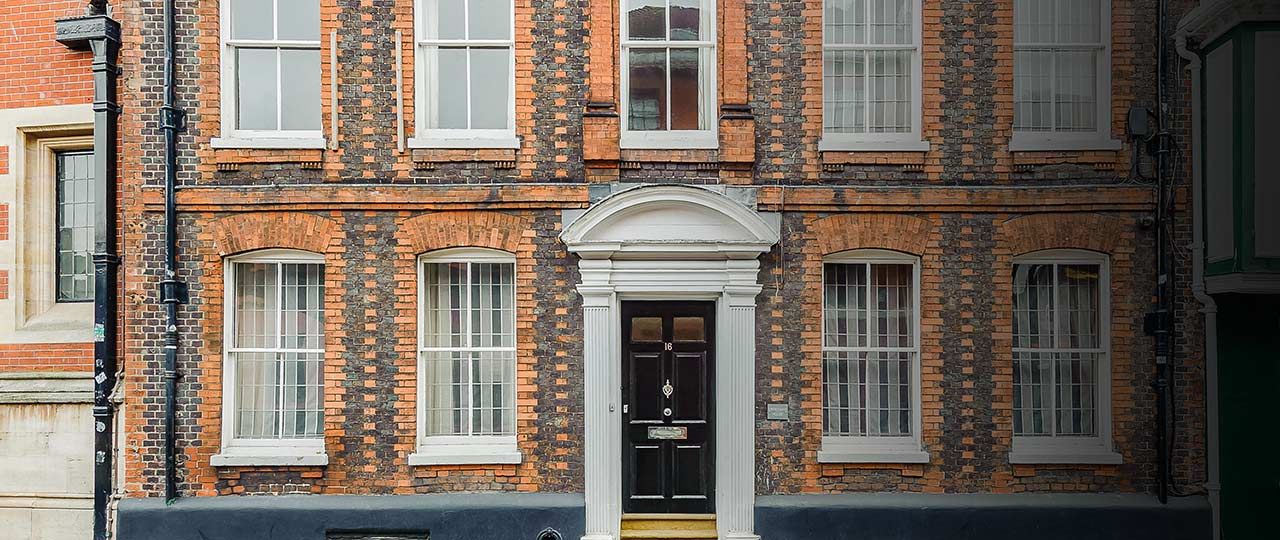
The humble brick is the bedrock of British house building, but it’s anything but boring. We look at how brick has been used over the centuries to create much-loved period features and ornate designs.
Brick has been used as a building material since the Roman era. Its versatility both for construction and decoration has led to its use in a vast range of properties from estate cottages to grand palaces.
In this article, we look at how brick designs have influenced the period properties that are so popular today.
Early vernacular architecture
Before the mid-17th century, almost all homes were built using local materials. While some parts of the country had access to an abundance of stone or wood, much of the southeast was built on, and using, clay. Some of the oldest examples of brick architecture can be found here.
The English bond is one of the oldest types of brick bonding and consists of alternating rows of stretchers (bricks placed lengthways) and headers (bricks placed end on). It was popular until the late 17th century and a few examples still remain today, such as Mock Beggar Hall in Norfolk.
Tudor brickwork and stylish chimneys
During the Tudor period, the homes of ordinary people were typically cob-walled or timber-framed. The frame was usually filled with waffle and daub but occasionally brick was used. Littlecourt, a beautiful Grade II listed thatched house with origins dating back to Tudor times, is a great example of this.
For wealthier homeowners, brickwork was the norm. But it wasn’t just used to build walls. Ornate brick chimneys were in fashion, and the 241 elaborately carved chimney stacks at Hampton Court Palace clearly show the skill of the craftsmen of this period. Plaish Hall is believed to be the first brick built house in Shropshire and has chimneys reminiscent of those at Hampton Court Palace, along with classic red English bond brickwork and blue diapering.
Georgian design
Different styles of bricklaying became popular during the Georgian period, including the distinctive Flemish bond. This is created by laying alternate stretches and headers in a single brick course. The next course of bricks is laid so the header sits above the middle of the stretcher in the course below.
Alton House, a Grade II listed townhouse in Wantage, is a great example of traditional Flemish bond construction. Lime mortar was typically used as the bonding material in Georgian times and really sets off the colour of the brick. In other houses, bricks of different colours were used to emphasise the regular pattern of brickwork and create ornate designs.
Due to their aesthetic appeal, Flemish designs are particularly popular with buyers looking for period properties.
Victorian industrial evolution
With the arrival of the railways, it became much easier to transport building materials around the country. During the Industrial Revolution, population explosions in cities led to a huge building programme of brick-built terraced houses. After 1850, manufactured bricks replaced handmade bricks, leading to more uniformity in construction and style.
Victorian architecture was very much influenced by the Gothic revival movement, featuring pointed arches, front facing gables and steeply pitched roofs. Red brick properties were popular, but the availability of different types of clay meant that coloured bricks were often incorporated into the facade design. The Gate House, on the outskirts of Windlesham in Surrey, is a great example of this styling.
Geographical characteristics
Across different periods, the use of local materials and craftsmen have created distinct architectural styles in different villages, towns and regions. On historic estates, workers’ cottages often mirrored the style of the manor house, and these unique period properties are much sought after today.
Hill Corner Cottage is a traditional brick-and-flint workers’ cottage that, along with Manor Farm Barn, is a great example of the brick houses with flint inlay that are particularly characteristic of parts of Sussex, Berkshire and Hampshire.
Brickwork today
The popularity of period design and architecture means that many homebuilders today look to the past for inspiration. Brick designs are used both for decoration and to fit in with the local vernacular. To really get a local, period feel for your new home, source handmade bricks made from local materials.
